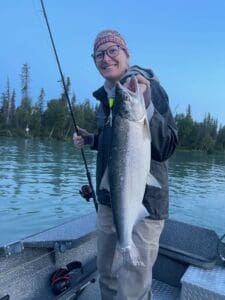Casting a spinning rod can be a slightly intimidating task to a rookie angler, but can also be learned quickly & easily with the assistance of an experienced and patient fishing guide. Our guides regularly turn hesitant casters into confident slingers in short order, and simply lobbing your lure out there is typically good enough to have a productive day of fishing on the Kenai River. But if you want to take your casting to the next level, avoid unnecessary frustration, and be more efficient and productive overall with a spinning rod in your hand, then below are 5 advanced details you’ll want to pay attention to.
Braided Line
When spooling your reel up, be sure to avoid the temptation of purchasing line that’s way too heavy for your application. Heavy line, especially monofilament, will drastically reduce your casting performance and you’ll only get a fraction of the distance you need out of your cast. Braided line has virtually no memory & much thinner diameter, and as a result provides amazing casting performance. For example, 20 pound braided line will cast a relatively light spinner (i.e Blue Fox #5 Vibrax) a very good distance, while 20 pound monofilament line would struggle mightily to get that same spinner to the fish. Another bonus of braided line is that it is very abrasion resistant. In my opinion, braided line is the only way to go when it comes to rigging your spinning rod for casting performance.
The Right Size Rod/Reel/Lure Combo
Every rod has a weight range printed right on the rod, so when you’re searching out the right rod/reel combo, make sure that the rating of your spinning rod matches the sizes of lures that you commonly utilize on the water. If your lure is too light for your rod, then you’ll lose some casting distance. If your lure is too heavy for your rod, you’ll lose some efficiency and accuracy in your cast.
Plenty of Line on the Spool
Braided line is somewhat costly, so it’s tempting to come up a little short when spooling your reel up. If you get frugal and fail to fill the spool fully, you’re paying the price by sacrificing some casting distance. Don’t over-do it, but definitely be sure to fill ‘er up!
No Bassmaster Casting Allowed
If you’ve ever watched professional bass anglers cast, most of them use some sort of fancy whipping motion in their cast to sling their lure out to the fish. While it might look cool to some, that’s not an effective (or safe) way to cast for any other angler. There’s a lot of stuff, and people, in close proximity of you when sharing a boat, so for safety’s sake if nothing else, a more controlled, single-motion cast is definitely the way to go. In addition to avoiding any unwanted piercings, you’ll also gain a lot of accuracy by keeping your cast simple. I teach guests on my boat to slowly bring their lure behind them, stop and look back to ensure their lure/hook isn’t in any kind of danger zone, then in one motion send their cast directly overhead. Use this strategy and you’ll avoid hazards, become a more accurate caster, and as a result you’ll likely have more fun and catch more fish!
Avoid Wind Knots
One of the only down-sides of braided line is that if your line gets tangled or knotted up, it’s often impossible to untangle. This can cause lots of frustration, reduce your effectiveness, and cost you a ton of time and money. Most anglers assume these wind-knots are simply inevitable when using braided line, but there’s actually one very important factor that will solve this issue for you once and for all. The key is the line between your reel and the first guide immediately after your cast lands… If there’s slack in this part of the line when you start to reel in, you’re risking an aggravating “wind knot” on the next cast, but if you ensure the line is tight each time you begin to reel in, you’ll avoid 99% of knots that would have occurred otherwise. You can accomplish this by either closing your bail just before the lure hits the water, or by raising the rod to tighten the line just before you begin reeling. Try it!
While chasing silver salmon and humpies this fall on the Kenai River, try all the strategies above and notice how much your spin-casting improves as a result. And don’t forget to let us know how it goes!


0 Comments